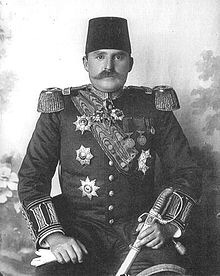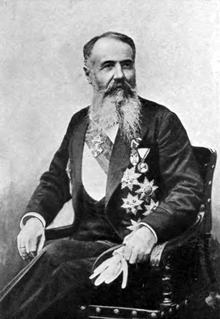Treaty of Niš (1914)
| The secret treaty of Serbian-Albanian alliance | |
|---|---|
 The Banovina building in Niš (which has been part of the University of Niš since 1966) where the treaty was signed | |
| Signed | 17 September 1914 |
| Location | Niš, Kingdom of Serbia |
| Negotiators | |
| Signatories | Kingdom of Serbia Republic of Central Albania |
The Treaty of Serbian–Albanian Alliance, also known as the Treaty of Niš,[1] was a secret treaty signed in Niš between Essad Pasha Toptani and prime minister Nikola Pašić of Kingdom of Serbia on 17 September 1914.
Background
On 17 May 1914 Essad Pasha Toptani was accused of assisting the Peasant Revolt against William of Wied.[2] He was exiled to Italy on 20 May without trial.[3][4] In Italy, he was received with honor since both Italian and Austrian representatives played roles in intrigues that surrounded the revolt.[5] Only a week after prince Wilhelm of Wied's departure from Durres on 3 September 1914, another violent revolt arose. The rebels managed to lay siege on Durres, imprison Wied's supporters, to call for Muslim prince and to establish the Senate for Central Albania.[6]

The Treaty

In autumn 1914 Essad Pasha decided to accept the invitation of the Senate of Central Albania to return and lead them.[7] First he travelled to Niš, Kingdom of Serbia, where he and Serbian prime minister Nikola Pašić signed the secret treaty of Serbian-Albanian alliance on 17 September 1914.[8] The treaty was signed in Banovina building (which has been part of the University of Niš since 1966), which is close to Niš fortress.[9]
The treaty had fifteen points which set up Serbian-Albanian political and military institutions and the military alliance of Albania and the Kingdom of Serbia. The treaty envisaged a rail-road to Durres, the financial and military support of the Kingdom of Serbia to Essad Pasha's position as Albanian ruler and it recorded the demarcation by a Serbo-Albanian commission.[10] The treaty allowed Essad Pasha to change some clauses because the treaty would need the agreement of the Albanian National Assembly. This would be possible after Pasha was elected ruler. Serbia contracted to supply a military intervention to protect Pasha's rule and to subsidise his gendarmerie by paying 50,000 dinars per month for Albanian military supplies.[11]
Aftermath
In October 1914 Essad Pasha returned to Albania. With Italian and Serbian financial backing he established armed forces in Dibër and captured the interior of Albania and Dures.[12]
References
- ^ "Banovina". Niš: Tourist Organization of Niš web site. Archived from the original on March 12, 2011. Retrieved March 12, 2011.
the "Treaty between Serbia and Albania", also known as "Nis Treaty"
{{cite web}}: Cite has empty unknown parameters:|separator=,|month=, and|coauthors=(help) - ^ Elsie, Robert. "Albania under prince Wied". Archived from the original on January 25, 2011. Retrieved January 25, 2011.
It was obvious to Wied and the Dutch officers that Essad Pasha had his hand in the unrest.
- ^ Heaton-Armstrong, Duncan (2005). "An Uprising in the Six-Month Kingdom". Gervase Belfield and Bejtullah Destani (I.B. Tauris, in association with the Centre for Albanian Studies). Archived from the original on January 25, 2011. Retrieved January 25, 2011.
Essad would be sent into exile, without a trial.
- ^ Elsie, Robert. "Albania under prince Wied". Archived from the original on January 25, 2011. Retrieved January 25, 2011.
to exile Essad Pasha to Italy
- ^ Jelavich, Barbara (1999) [1983], History of the Balkans: Twentieth century, vol. 2, Cambridge, United Kingdom: The Press Syndicate of University of Cambridge, p. 103, ISBN 0-521-27459-1, retrieved January 25, 2011,
The Italian and Austrian representatives played roles in intrigues surrounding this event...to Italy, and there received with honor.
- ^ Vickers, Miranda (1999). The Albanians: a modern history. I.B.Tauris. p. 85. ISBN 978-1-86064-541-9.
Barely a week after Wied's departure yet another violent revolt, this time led by supporters of Young Turks, laid siege on Durres. The rebels raised Ottoman flag, imprisoned Wied's supporters and called for, upon other things, a Muslim prince.... the insurgents set up a Senate for Central Albania
- ^ Bataković, Dušan T., "Serbian government and Essad Pasha Toptani", The Kosovo Chronicles, Belgrade, Serbia: Knižara Plato, ISBN 86-447-0006-5, archived from the original on January 19, 2011, retrieved January 19, 2011,
The senate of free towns in central Albania invited Essad Pasha to take over power.
{{citation}}: External link in|chapterurl=|chapterurl=ignored (|chapter-url=suggested) (help) - ^ Bataković, Dušan T., "Serbian government and Essad Pasha Toptani", The Kosovo Chronicles, Belgrade, Serbia: Knižara Plato, ISBN 86-447-0006-5, archived from the original on January 19, 2011, retrieved January 19, 2011,
Essad Pasha signed a secret alliance treaty with Pasic on September 17.
{{citation}}: External link in|chapterurl=|chapterurl=ignored (|chapter-url=suggested) (help) - ^ "Banovina". Niš: Tourist Organization of Niš web site. Archived from the original on March 12, 2011. Retrieved March 12, 2011.
Banovina building is located on the right bank of the Nisava, close to the entrance to the Fortress....On 4 September 1914 in this building the "Treaty between Serbia and Albania", also known as "Nis Treaty" was signed by Essad Pashё Toptani and Nikola Pasic.... since 1966 the building has been the seat of the University of Nis.
{{cite web}}: Cite has empty unknown parameters:|separator=,|month=, and|coauthors=(help) - ^ Bataković, Dušan T., "Serbian government and Essad Pasha Toptani", The Kosovo Chronicles, Belgrade, Serbia: Knižara Plato, ISBN 86-447-0006-5, archived from the original on January 19, 2011, retrieved January 19, 2011,
The 15 points envisaged the setting up of joint political and military institutions,... focused on a military alliance, the construction of an Adriatic railroad to Durazzo and guarantees that Serbia would support Essad Pasha's election as the Albanian ruler. ...The demarcation between the two countries was to be drawn by a special Serbo-Albanian commission
{{citation}}: External link in|chapterurl=|chapterurl=ignored (|chapter-url=suggested) (help) - ^ Bataković, Dušan T., "Serbian government and Essad Pasha Toptani", The Kosovo Chronicles, Belgrade, Serbia: Knižara Plato, ISBN 86-447-0006-5, archived from the original on January 19, 2011, retrieved January 19, 2011,
Essad Pasha was to confirm the treaty only upon being elected ruler, with consent from the National Assembly: this left maneuvering space for revising individual provisions. Serbia, at the invitation of Essad Pasha, carry out a military intervention to protect his regime Essad Pasha was to confirm the treaty only upon being elected ruler, with consent from the National Assembly: this left maneuvering space for revising individual provisions. Serbia was obligated to finance Pasha's gendarmery and supply the necessary military equipment by paying off 50,000 dinars per month.
{{citation}}: External link in|chapterurl=|chapterurl=ignored (|chapter-url=suggested) (help) - ^ Vickers, Miranda (1999). The Albanians: a modern history. I.B.Tauris. p. 87. ISBN 978-1-86064-541-9.
In October 1914 Essad returned to Albania, where he managed, with Italian and Serbian financial backing and a force raised in Diber - to march into interior of Albania to take Durres
